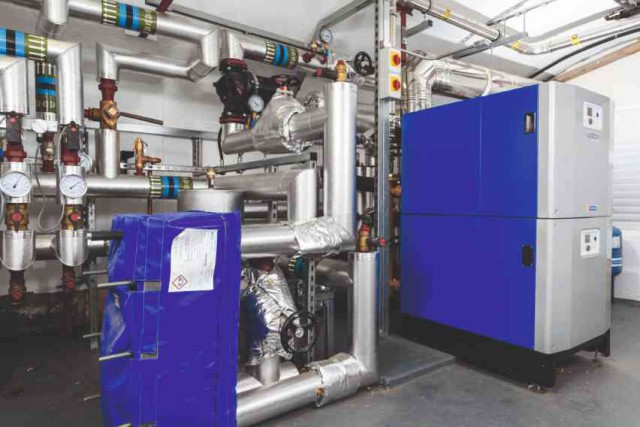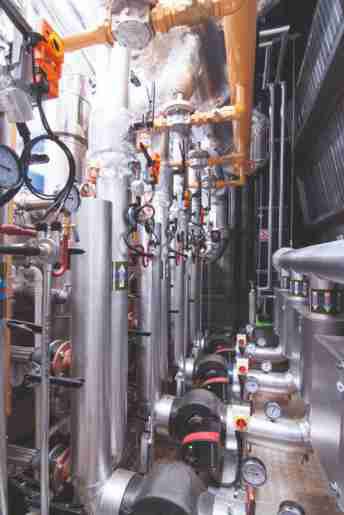Which is best – a primary circuit pump or boiler shunt pumps?

Barrie Welsh of Hamworthy Heating looks at different pump options with the pros and cons of each.
As discussed in CIBSE Guide B1 any heating system, regardless of size or complexity, consists of three sections: the primary circuit, which contains the heat generators; the secondary circuits that contain the heat emitters; and the hydraulic connection between the primary and secondary circuits.
Primary circulation is important in maintaining correct system temperature output and ensuring boilers have the constant minimum flow rate as specified by the manufacturer. Your system flow will be managed by installing a pump or pumps into your primary circuit (unless your boilers have integral pumps). You’ll need to choose whether you want a single primary circuit pump or multiple boiler shunt pumps.
A question we get asked a lot at our CPD seminars is ‘Which is best - boiler shunt pumps or a primary circulation pump?’ There's no correct method, as long as the minimum flow is always maintained. And it will always depend on the project. In this article we’ll look at the different pump options and their pros and cons, as well as suitability to different applications.
Single primary circuit pump
A single primary circuit pump application is where the entire primary circuit flow is dependent on a single large pump. This pump needs to be capable of circulating the entire primary circuit at the minimum flow rates specified for the boiler or boilers whilst overcoming the resistance created by the heat exchangers, pipework, fittings, and any resistance created by hydraulic breaks such as plate heat exchangers.
When a single primary circuit pump is installed providing circulation for a group (cascade) of boilers the combined flow rate for all boilers, pipe work, and hydraulic breaks must be added together and the highest resistance value used. Pipework should be configured as reverse return to ensure an even flow rate across the entire cascade. Some manufacturers design this concept into their bespoke pipe kits.
The primary pump must be set to a fixed flow. It is a common industry misconception that boilers can be forced to modulate by varying flow rates. However, boiler controls are not designed to do this and instead monitor flow and return temperatures. Attempting to “force modulate” modern boilers by varying flow rates from the pump will at best not produce the desired result and at worse, over prolonged periods, will damage the boiler heat cells.
In order to maximise energy efficiency, reduce electricity usage, and minimise potential heat losses through non-firing boilers, the installation of a 2-port valve on the flow or return of each boiler to serve as flow prevention is recommended. The individual valve would close when the boiler is not firing, stopping flow through the heat exchanger. The single primary circuit pump could then be controlled so that it reduces flow rate pro-rata for each closed valve. Due to the slow opening times of these valves, it’s important to ensure the boiler is set to not fire before correct flow is established.
This arrangement is beneficial when there is insufficient space to install dedicated boiler module shunt pumps and if the project is a refurbishment where an existing pump might be suitable for re-use.
Multiple boiler shunt pumps
Another method to maintain correct flow in the primary circuit is to circulate the water through each boiler using a dedicated shunt pump per boiler. The pump is installed in the return connection to each boiler module to isolate flow when the boiler module is not firing. Individual boiler pumps are wired to and controlled from their respective boiler module and usually provided with a 5 minute overrun period.
Again, the rules of flow still apply. Minimum flow for the boiler must be maintained and the pump must not be allowed to modulate. If using a plate exchanger care must be taken to ensure that the shunt pump(s) can overcome both the resistance created by the boiler, as well as the resistance of the pipework and fittings, and that of the plate exchanger itself.

You’ll need to check what boilers you are specifying and if they already come with integral pumps. Some manufacturers sell correctly-sized boiler shunt pumps as part of their boiler pipework kits.
Which method should I choose?
There is no correct method, as long as minimum flow is always maintained. However, there are some pros and cons to each:
Single primary circuit pump pros and cons
- You only need to purchase one pump making it simpler to install, maintain, and can be more cost effective. However, the physical size of the pump will be much larger than individual pumps. This can create installation and maintenance challenges, as often it will require a 3-phase power supply.
- By choosing a single pump you could be creating a single point of failure in the system. But this can be negated by installing a twin motor pump or two pumps as duty stand-by.
- Pipework can be more complex as you need to configure a reverse return. However, as mentioned previously, this is often built in to manufacturer’s pipework kits
- You may get potential heat losses through non-firing boilers
Multiple boiler shunt pumps pros and cons:
- By installing multiple pumps, you have an Increased system redundancy -should one pump fail you still have other pumps running on other boilers to maintain your heating
- The pumps will be physically smaller and thus simpler to install
- Modern boiler controls can often control the relevant boiler shunt pump which takes the important pump over-run time away from the external controls
- Reverse return configuration is not required in this case
- Flow is isolated through non-firing boilers
- Cost will be increased as there are more pumps to purchase and this also may result in additional maintenance due to the number of pumps
- There could be additional system complexity as there is increased requirements for electrical supplies and controls wiring to each pump
Which one should you choose?
Ultimately both options allow you to maintain flow rate across your primary circuit with multiple boilers running in cascade. The decision will be based on criticality of building usage and the balance of cost against system reliability and redundancy requirements.
For example; a building such as an office block that whilst inconvenient and possibly financially disruptive to be off-line for hours or potentially days but not vital may choose a single primary circuit pump with the possibility of twin head pump or duty / stand-by.
However, a system that simply cannot risk any downtime such as a hospital or prison may choose to install individual boiler shunt pumps. It would be considered that the installation and maintenance costs could negate the cost and disruption and potential human suffering that could result if the system were to fail and have downtime.
Barrie Welsh is Technical Sales Manager at Hamworthy Heating







